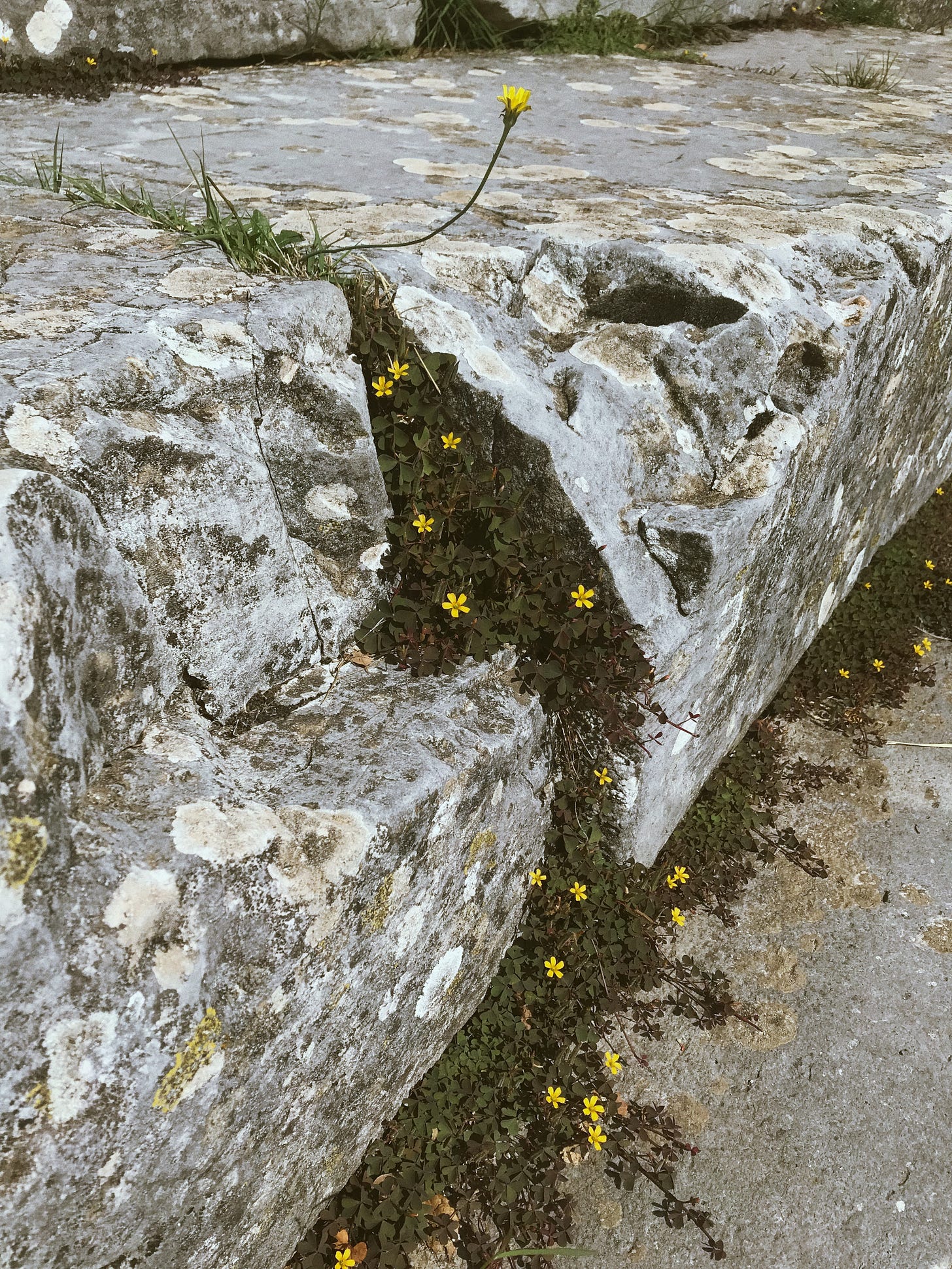
“La vita del popolo è stata, da sempre, legata ai campi, "al foro" (podere) e la sacra e pacifica convivenza è stata regolata con saggezza da usi e consuetudini che, insieme al culto dei campi, si sono tramandati di generazione in generazione [...]. Le nostre colline erano disseminate di vigneti, di oliveti e le valli biondeggiavano di messi, che divenivano rigogliose non certo per la fertilità del terreno, ma piuttosto per la sapiente, meticolosa e accurata lavorazione della terra.”1
I’ve never been to Molise in spring, but I’ve spent much of the last couple of years thinking, reading, and listening to tales about the seasons in the mountains and valleys, coasts and riverbanks of this region my family once called home.
Welcome to Crivellando, from crivello, a type of round sieve made with wide mesh, traditionally used by women (crivellatrici) to clean harvested olives by separating them from leaves and debris. The olives are tossed into the air and caught by the crivellatrici over and over again. Thank you for joining me as I explore folklore, family, oral history, and food as a third-generation Italian-Canadian molisana. This is, partly, a way for me to put thoughts to “paper.” But it’s also about (re)learning; building back a habit of writing about research and inspiration; connecting with a place I know through stories and ancestors. Ancestral stories. I expect the first few months to feel a little clumsy. Bear with me, please.
For all the cliché reasons you can probably imagine, spring just felt like the right time to start. The season symbolic of rebirth and new beginnings, in Molise, it is marked by the end of a fescte du percielle (festival of the pig), the migration of livestock from their low valley pastures in Puglia to the green mountain pastures of the molisani and abruzzesi Appenines (transhumance), and — in some villages — through special folkloric rites performed through the streets in early May. As part of my dreaming and scheming lately, I’ve been imagining a future where I can spend the entire festival season, from May to September, in Molise, hopping from village to village, eating all the traditional food, and listening to hundreds of stories.
Spring is also the origin. Ver Sacrum, sacred spring, when the ancient Samnites founded Bovaianom — present-day Bojano — looking for a new place to settle. Overcome by famine, the Samnite tribe left their original settlement guided by an ox. According to legend, the ox stopped to drink from the Biferno, the river whose source would mark the foundations of the future Samnite capital.2 Formed from the tears of a young woman, long, long before, the Biferno is a representation of the duties her love had to honour when he left her to walk the route of the transumanza back to Puglia, as the air of the Appenines got too cold for his sheep. Sobbing over the separation, her tears spilled over the land.
“Ella pianse per molti giorni e molte notti e le sue lacrime bagnarono le colline del Matese che bevvero, bevvero avidamente, incessantement, finché non ne furono sature, gonfie.”3
She first met her love in spring.
April chiagn e rid. April cries and laughs.
It releases. That last snow storm, those heavy downpours, the warmer spring sun — orange light, rising earlier and setting later —, the heavier air that doesn’t cut like a knife. I imagine it as a collective exhale. Breathe in. Hold it. Breathe out. Relax your shoulders, unclench your jaw. Spring is here.
Rascia, Maje! May it bring abundance.
In Fossalto, a small comune of just over 1000 inhabitants near Campobasso, this collective energy is channelled into the ritual of la Pagliara Maje Maje. Pagliara is the term used in the Italian South to describe a thatched hut with low walls. Made with straw — paglia — these huts are circular in shape and simple in design. The fossaltesi create a special pagliara as a personification of May (maje) on the first of the month. Branches from herbs, flowers, and trees intertwine to form a cone, which a man will wear over his body. On top of the cone, fossaltesi place a cross of flowers. The pagliara is paraded through the streets, accompanied by a zampognaro (bagpipe player), as paesani drench it in water poured from buckets out of their windows and off their balconies before gathering in the town square for a meal of vegetable soup, cheese, and bread.4
May first has been a significant day since ancient agricultural societies used it to herald the return of summer. Ancient Egyptian, Greek, Roman, and later Celtic and Germanic rituals involved collecting flowers and dancing around a may tree or pole. For Ancient Romans, it marked the middle of their five-day celebrations for Flora, goddess of flowers and vegetation. Through their Floralia ceremonies, Ancient Romans asked this goddess to protect the blooms and blossoms of the earth during the month named for Maia, embodiment of growth. And also for maiores — ancestors.5
May our efforts be fruitful. May our roots grow deep, thick, and strong.
Cass
See below for monthly tarot pull, footnotes, and resource list.
Monthly Tarot
Each issue will include a tarot pull reflecting on the research and folklore discussed in the newsletter.
Water reflects, sustains, makes fertile. It revives, quenches, and allows growth. The Biferno is made of tears full of love. They nourished the ox who touched his lips to the river, signifying that this would be the place where germination was possible, where community could thrive. As I look at this card, imagining all the stories and folklore I have read over the last weeks while planning for this first issue, one word comes to mind: source. Yes, the water is a source, as was the Biferno in the legends of the Samnite settlement at Bojano — the source for a future, for possibility, for life.
But the woman is also a source, replenishing the pool and the earth with her two jars. A source of hope and faith, but also, I think, of a concrete promise to both the land and the water she is connected, grounded to: I am here and I will be here.
When we look at the stars, we are looking back in time: “Our senses are stuck in the past. There’s a flash of lightning, and then seconds pass until we hear the rumble of distant thunder. We hear the past.”6 It’s said that the five little trickles of water coming from the jar in the woman’s left hand represent the senses, soaking the earth in her own interpretations of it. A constant reminder that the past is very much present. Fleeting, really. Behind us, but somehow always just one step ahead.
“The life of the people has always been linked to the fields, the farm, and the sacred and peaceful coexistence has been wisely regulated by customs and traditions that, together with the cultivation of the fields, have been handed down from generation to generation [...]. Our hills were dotted with vineyards, olive groves and valleys blossomed with crops, which flourished not for the fertility of the soil, but rather for the wise, meticulous and careful work on the land.” Nicolino Di Donato, Le Storie del “Fiumarello” (Campobasso: La Rapida Grafedit, 1983), 29.
"Ver Sacrum, Bojano torna alle origini sannite,” Primo Piano Molise, Aug. 22, 2017; “Ver Sacrum: la primavera sacra dei Sanniti,” Turismo in Molise.
“She cried for many days and nights and her tears wet the hills of the Matese that drank, drank greedily, incessantly, until they were saturated, swollen.” From "La leggenda del fiume Biferno,” in Mauro Gioielli, Fiabe, leggende e racconti popolari del Sannio (Isernia: Cosmo Iannone Editore, 1993), 275.
"La Pajara Maje Maje,” Rete italiana di cultura popolare, 2022; Mariateresa Di Lallo, “La tradizionale “Pajara” di maggio,” La Terra, Apr. 29, 2016.
N Lascu, “Ovidio Linguista,” Studii clasice, 1961, p. 307-313.
Michael J. I. Brown, “When you look up, how far back in time do you see?” The Conversation, December 26, 2018. https://theconversation.com/when-you-look-up-how-far-back-in-time-do-you-see-101176.
Resources
Beni Immateriali del Molise. “La Pagliara Maje Maje di Fossalto (CB).” YouTube, June 4, 2012.
Brown, Michael J. I. “When you look up, how far back in time do you see?” The Conversation, December 26, 2018. https://theconversation.com/when-you-look-up-how-far-back-in-time-do-you-see-101176.
Capini, Stefano and Angela Di Niro. Samnium: Archeologia del Molise. Campobasso: Casa Editrice Quasar, 1991.
Di Donato, Nicolino. Le Storie del “Fiumarello.” Campobasso: La Rapida Grafedit, 1983.
Di Lallo, Mariateresa. “La tradizionale “Pajara” di maggio.” La Terra, Apr. 29, 2016. http://www.laterra.org/index.php?option=com_content&view=article&id=689:la-tradizionale-pajara-di-maggio&catid=79&Itemid=343.
“Feste di primavera, i riti del primo maggio nei paesi molisani.” Turismo in Molise. https://www.turismoinmolise.com/feste-di-primavera/.
Gioielli, Mauro. Fiabe, leggende e racconti popolari del Sannio. Isernia: Cosmo Iannone Editore, 1993.
ISPRA. “Carta della Natura della regione Molise: cartografia e valutazione degli habitat alla scala 1:25.000.” Rapportti 348, 2021. https://www.isprambiente.gov.it/files2021/pubblicazioni/rapporti/rapporto_348_2021.pdf.
"La Pajara Maje Maje.” Rete italiana di cultura popolare, 2022. https://www.reteitalianaculturapopolare.org/fr/calendario-dei-riti-e-delle-feste/feste-primavera/231-la-pajara-maje-maje.html.
Lascu, N . “Ovidio Linguista.” Studii clasice, 1961, p. 307-313.
“The Pagan Spring Fertility Origins of May Day.” Wilder Utopia. May 1, 2019. https://wilderutopia.com/traditions/the-pagan-spring-fertility-origins-of-may-day/.
Pop Molise, https://www.popmolise.it/spazio_sfuso.php
“The Transumanza.” Made in South Italy. http://www.madeinsouthitalytoday.com/the-transumanza.php.
"Ver Sacrum, Bojano torna alle origini sannit.” Primo Piano Molise, Aug. 22, 2017. https://www.primopianomolise.it/citta/bojano/57216/ver-sacrum-bojano-torna-alle-origini-sannite/.







